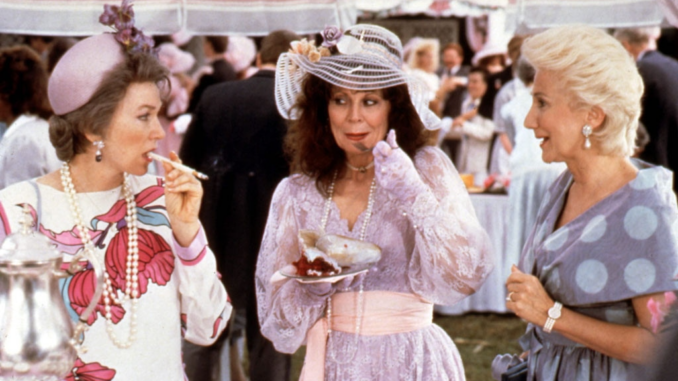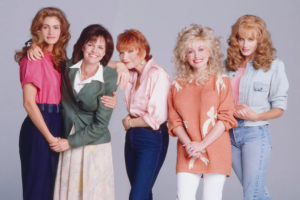
What bride, when planning her vows, hasn’t declared, “My colors are blush and bashful”?
No? Just us?
Thirty-five years ago, those words were being uttered by a promising young thespian named Julia Roberts. Only 21 and with just seven credits to her name when filming began on Steel Magnolias, the Georgia native more than held her own among the likes of Dolly Parton, Sally Field, Olympia Dukakis, Daryl Hannah and Shirley MacLaine in a film about a coterie of woman in a small Southern community and how they deal with the death of one of their own.
Based on a true story, the 1989 tearjerker was meant as a tribute to playwright Robert Harling‘s sister Susan, who passed due to complications from diabetes.
Following the success of the 1987 play of the same name, director Herbert Ross adapted it for the big screen, creating a star-studded Hollywood production that took over the small town of Natchitoches, La.
“The L.A. people required things that you didn’t find at the local Piggly Wiggly,” Harling recalled to Garden and Gun in a 2017 look back. “I remember the manager of the store saying to a local reporter, ‘Yep, if it hadn’t been for Herbert Ross, nobody around here would know the difference between ostera and beluga.”
Caviar knowledge aside, the female-forward flick (noting how no men appeared in the stage version, The New York Times‘ critic complained that in the film iteration “the male characters are no more substantial now than when they were invisible”) became one of the top-grossing films of 1989.
Roberts, the least known member of the cast, earned her first of four Oscar nominations for her turn as newlywed Shelby, who’s in fragile health but willing to risk her life for just a few years as a mom.
Off-camera, the success stories were just as real, with MacLaine declaring that the summer camp-style filming experience bonded them for life. Allow us to fill y’all in.
1. The movie came this close to never happening. Because, actually, Robert Harling never intended to be a playwright, earning a degree at Tulane University Law School before following his acting dreams to New York City. After his beloved younger sister got sick and passed away, however, he was inspired. “I wrote it to somehow get this true story off my chest and to celebrate my sister in the process,” he told The Huffington Post in 2014.
Like Steel Magnolias‘ Shelby, he told Garden and Gun, Susan’s diabetes meant bearing kids could be life-threatening: “But she wanted a child, she went ahead and had a child, and then, sure enough, her metabolism started to fail—circulatory system, kidneys, the whole thing. It was much grimmer than I portrayed in the play.”
Initially he intended to write a short story, in part to share with his nephew one day to explain what happened to his mom. But a few pages in, he felt he wasn’t accurately capturing the women’s dialogue, so he switched course. Within 10 days, he’d scribbled out an entire play.
2. The names were also based on a true story. Shelby’s mother M’Lynn (Sally Field) was taken from a close friend. Shelby (Julia Roberts) was the name of one of his mother’s cousins, Clairee (Olympia Dukakis) “a fabulous aunt” and Ouiser (Shirley MacLaine) from his sister’s best friend. “She in no way resembled the character,” he said of the town curmudgeon. “But there was just something about the name that fit.”Personalities were also lifted from the people he grew up with in Louisiana. “I’ve never told a living soul who Ouiser is based on,” he shared, saying he was worried it might offend. But when people came to see it, “Lo and behold, every woman in town was saying, ‘He based Ouiser on me.'”
3. They didn’t expect people to find the funny. “We played it like a drama,”said Margo Martindale, who took on the part of hairdresser Truvy in the play, largely set in the town salon. (Her role was later adopted by Dolly Parton.) “And then the first night it was in front of an audience, we were shocked. It was riotously funny and played straight as an arrow.” The way Harling sees it, he just happened to know a lot of hilarious ladies. “They all love one-liners and they talk in bumper stickers,” he told Huffington Post, “and they’re sharp, funny women.”
4. For the family, the story was a place to openly grieve. “That play really did work miracles,” Harling’s brother John told Garden and Gun, “and I don’t use that term lightly.” Echoed his father, Bob, “I felt happy, I felt sad, I just couldn’t believe what was happening. But I was mostly feeling good, proud. It was a memorial to my daughter.”
As such, Harling’s father, uncle and next-door neighbor all invested in the production. At first he worried about the cash they’d lose, then he realized that wasn’t the motivation: “They weren’t looking to make money, they wanted to support the continuation of the saga.”

5. The movie came together as quickly as the play. Producer Ray Stark was among those approaching Harling to take the play to Hollywood.
He floated the idea of shooting in his hometown and promised to “get the greatest cast you can imagine,” Harling told Huffington Post. “That’s how it came to me and then Ray got Herbert Ross to direct it and then it was this domino effect of superstar after superstar.”
6. Revealing that “somebody had told Elizabeth Taylor that M’Lynn was the perfect role for her,” Harling recounted that when she came to see the play, “I was thinking at the time, ‘Elizabeth Taylor’s going to sit there and hear the line, ‘When it comes to suffering, she’s right up there with Elizabeth Taylor.’ No one laughed harder than she did.”
7. Bette Davis made a hard sell. Harling actually assumed he was being pranked when the film icon rang, inviting him for tea at her New York City hotel. Once there, she pitched herself as Ouiser, Elizabeth Taylor for M’Lynn and Katharine Hepburn for Clairee.
“It was fantastic,” Harling told The Huffington Post. “If I ever write a book, it’s a complete, incredible chapter. She basically, bless her heart, wanted to show that she was up and at ’em and doing it. There was nobody else and she was looking fabulous.” And taking no prisoners. Telling the story to The Morning Call in 1989, he recounted her parting phrase: “You may give the role of Ouiser to someone else. But you and they will hear from Bette Davis.”
8. But it’s hard to argue with Shirley Maclaine. When director Ross sent the script over to the Oscar-winner, he said any part was hers except for M’Lynn and Shelby.”So I read it and I said, ‘I want to play the really b–chy one,'” she recounted to Garden and Gun. “I think I was rehearsing for my old age. I was seeing if I could get away with saying what I negatively felt and still be funny. And it’s kind of turned out that way, actually.”
9. Meg Ryan turned them down. Which, in retrospect, it’s hard to say she made the wrong call. “The day we offered it to her, she came back and said, ‘I just got offered this movie with Billy Crystal, When Harry Met Sally, and that’s my chance to be a leading lady,'” Harling remembered. “‘In Steel Magnolias I’d be part of an ensemble.'”
10. While producers had a list of known stars they were considering, including Laura Dern and Winona Ryder, “The casting director said, ‘There’s this girl. She hasn’t been able to audition because she’s been off making some movie about pizza,” said Harling. When the Georgia native came in, fresh from filming Mystic Pizza, “It was like somebody bumped up the lights. She smiled that smile. She was the essence of the great Southern gal: spicy, witty, smart, with a layer of compassion underneath.”
11. Nicole Kidman took a stab as well. One of the Aussie actress’ earliest parts was Shelby in the Sydney production of the play. 12. And it turns out Maclaine has an eye for talent. “The moment Julia walked into the reading, I thought, ‘That woman is going to be a star,'” she told Garden and Gun. “I called my agent and said, ‘I don’t know if she has an agent, but you should handle her.'”
13. Because Stark insisted they film on location, the cast trucked down to Louisiana. “It helped that Natchitoches is gorgeous,” said Harling. “Anywhere you point the camera you’re going to frame a good shot.”
But bringing in the necessary equipment, plus finding rental accommodations for the big-named stars, turned the production into an extravaganza. As Harling put it, “The circus had come to town.”
14. Every night Parton and her squad (an assistant, bodyguard and hair stylist) dined at the same spot, “a restaurant called Mariner’s out on Sibley Lake,” resident Tom Whitehead recalled to Garden and Gun. As a result, the seafood spot remained sold out for the whole of the shoot as “people filled it up to see Dolly Parton eating in the back corner.”
15. Louisiana in the summertime presented some challenges. But while MacLaine admitted most of the cast were “always complaining” about the heat, there was never a peep from Parton.
“There was Dolly with a waist cincher no more than 16 inches around and heels about two feet high and a wig that must have weighed 23 pounds,” said the star. “And she’s the only one who didn’t sweat.”
Even when a Christmas scene required her to swelter in a cashmere sweater. “Julia said, ‘Dolly, we’re dying and you never say a word. Why don’t you let loose?'” Harling recounted. “Dolly very serenely smiled and said, ‘When I was young and had nothing, I wanted to be rich and famous and now I am. So I’m not going to complain about anything.”
